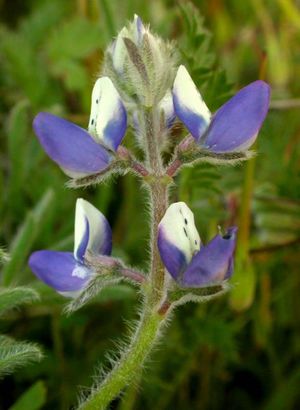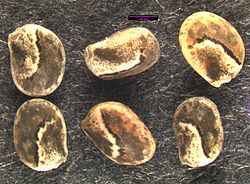Difference between revisions of "Lupinus bicolor"
| (26 intermediate revisions by 4 users not shown) | |||
| Line 1: | Line 1: | ||
| − | ===Plant=== | + | * Scientific Name: ''Lupinus'' ''bicolor'' |
| − | + | * Family: Fabaceae | |
| + | * Common Names: field lupine, small-flowered lupine, two-color lupine | ||
| + | * Synonyms/Misapplications: ''Lupinus'' ''hirsutulus, L.'' ''micranthus, L.'' ''polycarpus, L.'' ''strigulosus'' | ||
| + | * Codon: LUPBIC | ||
| + | ---- | ||
| + | [[File:LUPBIC8.jpg |thumb|Photo by Ben Legler, 2004, also featured on Main Page]] | ||
| + | ===Taxonomy=== | ||
| + | {{Taxobox | ||
| + | | image = | ||
| + | | image_caption =Photo by Ben Legler, 2004. Featured on Main Page | ||
| + | | name = | ||
| + | | regnum = [[Plant]]ae | ||
| + | | subregnum = Viridiplantae | ||
| + | | phylum = Tracheophyta | ||
| + | | subphylum= Spermatophytina | ||
| + | | classis = Magnoliopsida | ||
| + | | subclassis = Rosanae | ||
| + | | ordo = Fabales | ||
| + | | familia = Fabaceae | ||
| + | | genus = ''Lupinus'' L. | ||
| + | | species = ''''' Lupinus bicolor''''' Lindl. | ||
| + | | subspecies = | ||
| + | }} | ||
| + | <ref>Integrated Taxonomic Information System. Retrieved from https://www.itis.gov/servlet/SingleRpt/SingleRpt?search_topic=TSN&search_value=25966#null</ref> | ||
| − | + | ===Description=== | |
| − | + | ||
| − | + | ||
| − | + | ||
| − | + | Native taprooted annual, up to 4 dm tall. | |
| − | + | ||
| − | + | Leaves are alternate, palmately compound with 5-8 leaflets, appressed hairy on one or both sides.<ref name=":0">In Klinkenberg, Brian. (Editor) 2020. ''E-Flora BC: Electronic Atlas of the Plants of'' | |
| + | British Columbia'' [eflora.bc.ca]. Lab for Advanced Spatial Analysis,'' | ||
| + | Department of Geography, University of British Columbia, Vancouver. [Accessed: 2020-06-08 12:03:17 PM ]</ref> | ||
| − | + | Produces one, sometimes branched, flowering stem, on which flowers are scattered, not whorled.<ref name=":0" /> Papillonaceous flowers are pale blue to deep purple, with a white area on the banner, often with blue or purple spots, which turns magenta after pollination.<ref name=":1">Bowcutt, F., & Hamman, Sarah. (2016). ''Vascular plants'' | |
| − | + | of the South Sound prairies'' (First ed.). Olympia, Washington: The Evergreen'' | |
| + | State College Press.</ref> The keel is white, generally pointed, with ciliate upper margins.<ref>Teresa Sholars & Rhonda Riggins 2012, ''Lupinus bicolor'', in Jepson Flora Project (eds.) ''Jepson eFlora'', /eflora/eflora_display.php?tid=31793, accessed on June 08, 2020.</ref><ref name=":2">Hitchcock, C. L., Cronquist, A., Giblin, D., & Legler, | ||
| + | B. et al. (2018). ''Flora of the Pacific Northwest: an illustrated manual''. | ||
| + | Seattle: University of Washington Press.</ref> | ||
| − | = | + | The pods are appressed-hairy, bearing 4-8 seeds.<ref name=":0" /> |
| − | + | ||
| − | ''' | + | ===Bloom Period=== |
| + | April to July.<ref name=":1" /> | ||
| + | ===Distribution=== | ||
| + | Chiefly west of the Cascades in Washington state, but also in southeastern part of state via the Columbia River Gorge; British Columbia south to California, east to Arizona.<ref name=":2" /> | ||
| + | |||
| + | ===Habitat=== | ||
| + | Open, gravelly and sandy sites, prairies.<ref name=":2" /> | ||
| + | |||
| + | ===Uses=== | ||
| + | Important nectar source for bees.<ref>''Plant Database''. Lady Bird Johnson Wildflower Center - The University of Texas at Austin. (2018, November 30). <nowiki>https://www.wildflower.org/plants/result.php?id_plant=LUBI</nowiki>.</ref> | ||
| + | |||
| + | Host plant for the Arrowhead Blue butterfly.<ref>''Miniature Lupine, Lupinus bicolor''. California Native Plant Society. <nowiki>https://calscape.org/Lupinus-bicolor-()</nowiki>.</ref> | ||
| + | |||
| + | According to Welch, there is documentation of Northern Pomo use as food, the whole plant, except the roots, baked and eaten as greens, and young greens eaten fresh.<ref>Welch, J. R. (2013). In ''Sprouting valley historical ethnobotany of the northern pomo from Potter Valley, California'' (pp. 87–87). essay, Society of ethnobiology.</ref> | ||
| + | |||
| + | Several species in the ''Lupinus'' genus are important food plants. | ||
| + | |||
| + | ===Seed=== | ||
| + | [[File:Lupinus bicolor.jpg|250px|thumb|''Lupinus bicolor'' seeds, photo by Lisa Hintz]] | ||
'''Seed sample from:''' 2011 | '''Seed sample from:''' 2011 | ||
| Line 34: | Line 75: | ||
Seed surface smooth and glossy, with some small concave pockets. | Seed surface smooth and glossy, with some small concave pockets. | ||
| − | |||
'''Latitudinal Cross Section:''' elliptical [[File:LUBI-lat-crosssection.png]] | '''Latitudinal Cross Section:''' elliptical [[File:LUBI-lat-crosssection.png]] | ||
| Line 40: | Line 80: | ||
'''Longitudinal Cross Section:''' elliptical [[File:LUBI-long-crosssection.png]] | '''Longitudinal Cross Section:''' elliptical [[File:LUBI-long-crosssection.png]] | ||
| + | {{Basics}} | ||
| − | + | ===Photo Gallery=== | |
| − | + | <gallery> | |
| + | File:LUBI AnitaGoodrich flw good.jpg| Photo by Anita Goodrich | ||
| + | File:LUBI PatMontegue flw good.jpg| Photo by Pat Montegue | ||
| + | File:LUPBIC1.jpg|Young growth, courtesy CNLM | ||
| + | File:Lupinus bicolor.jpg| Seed, photo by Lisa Hintz | ||
| + | </gallery> | ||
| + | ===References=== | ||
| + | <references /> | ||
Latest revision as of 21:41, 20 March 2021
- Scientific Name: Lupinus bicolor
- Family: Fabaceae
- Common Names: field lupine, small-flowered lupine, two-color lupine
- Synonyms/Misapplications: Lupinus hirsutulus, L. micranthus, L. polycarpus, L. strigulosus
- Codon: LUPBIC
Contents
Taxonomy
| Scientific classification | |
|---|---|
| Kingdom: | Plantae |
| Subkingdom: | Viridiplantae |
| Phylum: | Tracheophyta |
| Subphylum: | Spermatophytina |
| Class: | Magnoliopsida |
| Subclass: | Rosanae |
| Order: | Fabales |
| Family: | Fabaceae |
| Genus: | Lupinus L. |
| Species: | Lupinus bicolor Lindl. |
Description
Native taprooted annual, up to 4 dm tall.
Leaves are alternate, palmately compound with 5-8 leaflets, appressed hairy on one or both sides.[2]
Produces one, sometimes branched, flowering stem, on which flowers are scattered, not whorled.[2] Papillonaceous flowers are pale blue to deep purple, with a white area on the banner, often with blue or purple spots, which turns magenta after pollination.[3] The keel is white, generally pointed, with ciliate upper margins.[4][5]
The pods are appressed-hairy, bearing 4-8 seeds.[2]
Bloom Period
April to July.[3]
Distribution
Chiefly west of the Cascades in Washington state, but also in southeastern part of state via the Columbia River Gorge; British Columbia south to California, east to Arizona.[5]
Habitat
Open, gravelly and sandy sites, prairies.[5]
Uses
Important nectar source for bees.[6]
Host plant for the Arrowhead Blue butterfly.[7]
According to Welch, there is documentation of Northern Pomo use as food, the whole plant, except the roots, baked and eaten as greens, and young greens eaten fresh.[8]
Several species in the Lupinus genus are important food plants.
Seed
Seed sample from: 2011
Average Measurement: 2.4 x 1.9 x 0.9
Measurement Range: L: 2 - 3, W: 1.75 - 2.25, D: 0.75 - 1
Features
Color: Seeds mostly brown, speckled with brown, gray, off-white, and/ or black. Seeds have distinctive black splotchy line that crosses the lateral seed face to encircle the hilum, inside of which is another similar white line. Seed edges are less heavily speckled with dark colors, giving them a more off-white appearance.
Surface: Seed surface smooth and glossy, with some small concave pockets.
Latitudinal Cross Section: elliptical ![]()
Longitudinal Cross Section: elliptical ![]()
Basic Explanations and Assumptions:
The dimensions for the seeds are length x width x depth. The location of the hilum is used as the base of the seed, and the length is measured from hilum to the opposite apex. Where a style is present, the length is measured from the hilum to the bottom of the style. Width is measured at a right angle to the length at the widest part. Depth is measured at a right angle to the intersection of height and width lines.
Measurements included are the mean average for each measurement of ten separate seeds.
All measurements in millimeters unless otherwise noted.
Photo Gallery
References
- ↑ Integrated Taxonomic Information System. Retrieved from https://www.itis.gov/servlet/SingleRpt/SingleRpt?search_topic=TSN&search_value=25966#null
- ↑ 2.0 2.1 2.2 In Klinkenberg, Brian. (Editor) 2020. E-Flora BC: Electronic Atlas of the Plants of British Columbia [eflora.bc.ca]. Lab for Advanced Spatial Analysis, Department of Geography, University of British Columbia, Vancouver. [Accessed: 2020-06-08 12:03:17 PM ]
- ↑ 3.0 3.1 Bowcutt, F., & Hamman, Sarah. (2016). Vascular plants of the South Sound prairies (First ed.). Olympia, Washington: The Evergreen State College Press.
- ↑ Teresa Sholars & Rhonda Riggins 2012, Lupinus bicolor, in Jepson Flora Project (eds.) Jepson eFlora, /eflora/eflora_display.php?tid=31793, accessed on June 08, 2020.
- ↑ 5.0 5.1 5.2 Hitchcock, C. L., Cronquist, A., Giblin, D., & Legler, B. et al. (2018). Flora of the Pacific Northwest: an illustrated manual. Seattle: University of Washington Press.
- ↑ Plant Database. Lady Bird Johnson Wildflower Center - The University of Texas at Austin. (2018, November 30). https://www.wildflower.org/plants/result.php?id_plant=LUBI.
- ↑ Miniature Lupine, Lupinus bicolor. California Native Plant Society. https://calscape.org/Lupinus-bicolor-().
- ↑ Welch, J. R. (2013). In Sprouting valley historical ethnobotany of the northern pomo from Potter Valley, California (pp. 87–87). essay, Society of ethnobiology.






